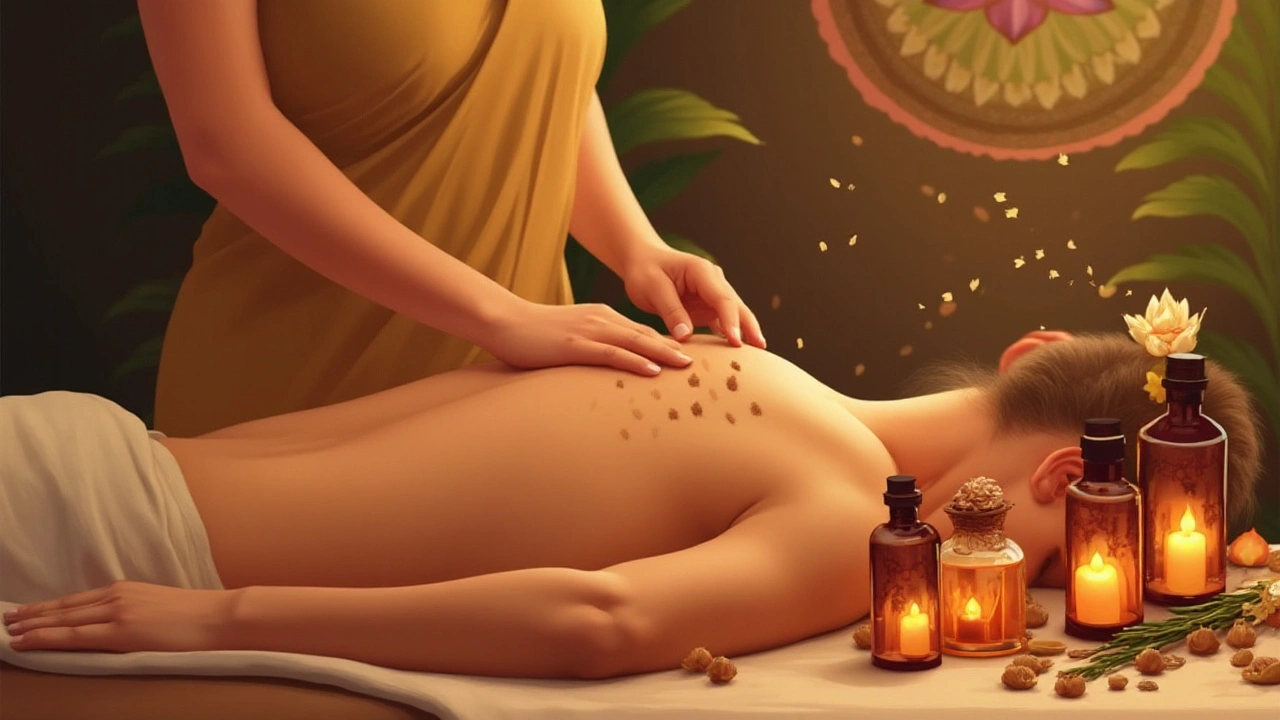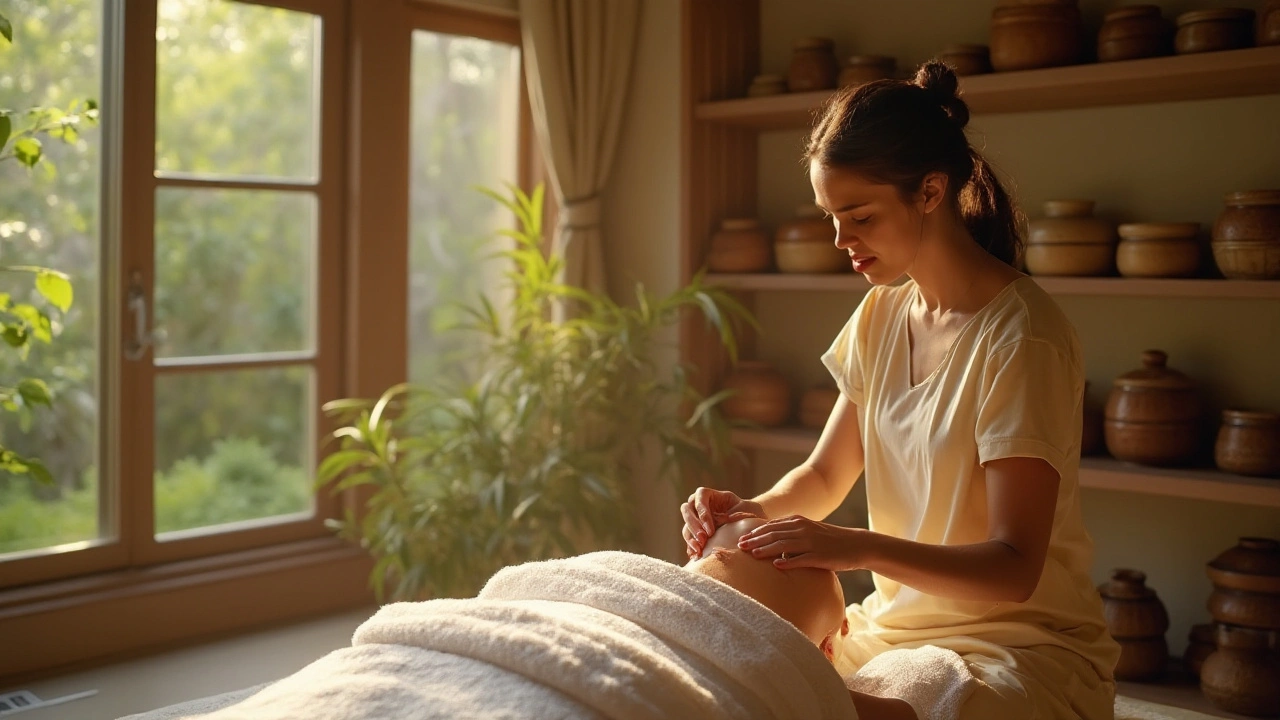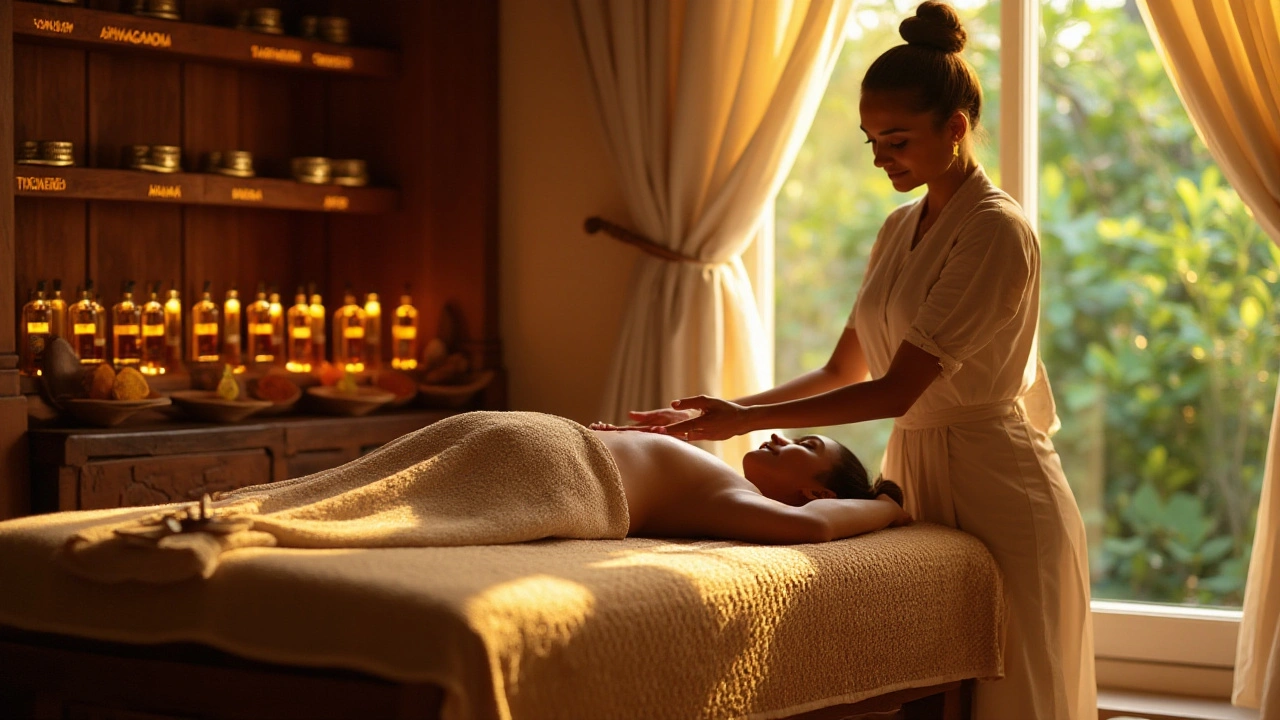Ayurvedic massage encapsulates a tradition rich in vigor and serenity, an experience unlike the ordinary rub-downs you may have encountered. Originating from the ancient Indian science of Ayurveda, these hands-on techniques focus on harmonizing the body, mind, and spirit. The methodologies emphasize unique energy points, known as 'marma,' while employing luxurious oils infused with therapeutic herbs.
What sets Ayuvedic massage apart is its inherent capacity to personalize the therapy process. It's not simply about untangling knots or soothing muscles but about tailoring the experience to foster deep healing. This revolves around the balance of three doshas—or fundamental energies—within the body: Vata, Pitta, and Kapha.
Join me in unraveling this ancient art form, tapping into the timeless wisdom that nurtures well-being from the inside out. Whether you're a seasoned practitioner or a curious newcomer, these insights provide you with the knowledge to embrace Ayurvedic massage as a profound wellness journey.
- Understanding the Fundamentals of Ayurvedic Massage
- The Power of Marma Points
- Mindful Oil Selection
- Exploring Major Massage Techniques
- Healing Benefits for Mind and Body
- Tips for Practitioners and Recipients
The Power of Marma Points
The world of Ayurveda opens us to the healing wonders called 'marma' points, ancient energy gateways mapped meticulously across the body. With roots extending back thousands of years, these points are akin to acupuncture meridians but hold a distinct place in the Ayurvedic tradition. Sitting at the confluence of muscles, veins, ligaments, bones, and joints, marma points serve as the critical junctures for the body's vital life force, or 'prana'. By targeting these points through specific massage techniques, deeper healing pathways are unlocked, rejuvenating both the physical and subtle layers of the being.
Each marma point has its own essential role in how energy flows and communicates within the body. Fascinatingly, there are 107 classic marma points identified, each corresponding to certain physiological and mental functions. When these points are stimulated through strategic Ayurvedic massage, the dosage between our body’s primary humors — Vata, Pitta, and Kapha — naturally finds its balance. It's a dance of energy, harmonizing subtle patterns that can often remain unseen yet deeply felt. This tradition of working with marma for healing is said to be as ancient and revered as Ayurveda itself. A.V. Aniruddha, a prominent Ayurvedic scholar, notes,
“Marma, when activated, can rediscover the innate intelligence of our tissues, reigniting the body's intrinsic healing capacity.”This perspective reflects a deep philosophical alignment between physical touch and energy modulation, underscoring the holistic potential of marma therapy.
In practice, Ayurvedic massage therapists intuitively tune into these points, employing specific oils that align with individual constitutional needs and current states of imbalance. Through firm, rhythmic motions and gentle pressure, these points are activated, inviting an expansive flow of energy that permeates through all layers of existence. The skilled hands of a therapist, combined with their profound knowledge of marma points, facilitate a reconnection to one’s intricate inner workings. As a result, such therapy can unlock stagnant energies and encourage pivotal detoxification processes, enhancing the wellness journey.
Beyond the physical, marma points also echo into the realms of mental and emotional well-being. Many practitioners report shifts in their mental clarity, creative thinking, and enhanced emotional resilience after just a few sessions centered around marma activation. It’s not just the unraveling of tension or easing of muscle stress; it’s a tapestry of intricate benefits stemming from this profound practice. Navigating the extraordinary practice of marma massage can lead one to unexplored realms of inner calm and vitality, making every session an invaluable experience on the path to supreme health.
Mindful Oil Selection
The journey of Ayurvedic massage finds its grounding in the nature-powered immersion of oils; these are far more than mere lubricants. Each oil is a deliberate choice, crafted to harmonize with an individual's unique constitution. In the ancient practice of Ayurveda, oils are revered for their capacity to deeply penetrate and nurture the body, acting as vessels that carry the healing properties of medicinal herbs. But how does one navigate the spectrum of oils available and choose wisely?
Firstly, it's crucial to understand one's own dosha. If you identify as Vata, known for airy, cold qualities, grounding and warming oils such as sesame or almond may be your allies. These oils not only provide warmth but are viscous enough to offer much-needed nourishment and moisturizing effects. They are often enriched with herbs like ashwagandha or brahmi to soothe Vata-induced anxiety and restlessness.
Pitta, characterized by intense fire and heat, finds balance with cooling, light oils such as coconut or sunflower. These oils help to pacify the skin's sensitivity and any inflammatory tendencies. To enhance their calming effect, herbs like sandalwood and rose can be infused, working as an aromatic balm to Pitta's sharp edges.
For those of the Kapha dosha, rich with earth and water elements, the choice may lean towards warming and stimulating oils like mustard or safflower. Elevating circulation and invigorating the mind, these oils are often infused with herbs like eucalyptus or rosemary, which help combat sluggishness and enhance alertness.
In the wise words of the renowned Ayurvedic practitioner Dr. Vasant Lad, "Oil is love from the plant and the earth to our bodies."
Indeed, mindful selection of oils is an act of love and care, acknowledging the subtle energies and needs of every individual.Appropriately chosen oils speak to cellular memory, and, in the practice of marma therapy, they play a role in unlocking energy pathways while detoxifying the system.
To optimize benefits, consider this simple guideline: choose oils that resonate with your senses. The scent should evoke a natural attraction; it stabilizes the mind and amplifies the therapeutic properties. The texture and warmth should comfort and connect with the skin, enhancing the subtle dialogue between body and oil.

Exploring Major Massage Techniques
The realm of Ayurvedic massage is a tapestry of techniques, each crafted to target specific aspects of one's physical and mental wellness. These methods weave together the philosophy of Ayurveda with hands-on therapy to harness healing powers. At the heart of these practices lies Abhyanga, which is probably the most recognized technique. In this massage, warm herbal oils are lavishly applied over the entire body, with the masseur using rhythmic strokes that align with the body's energy channels. This doesn't just heat the body's superficial layers; it penetrates deeply, assisting in detoxification and revitalizing the lymphatic system.
Another key technique is Shirodhara, where a steady stream of warm oil is gently poured over the forehead, often in sync with the recipient's breath and the sacred vibrations of ancient Indian mantras. Shirodhara is reputed for its ability to induce a deep state of relaxation and has been utilized in treating anxiety and insomnia. It helps soothe the mind, allowing the rest of the body to follow in a state of tranquility. There's an art in orchestrating this oil flow, one that requires harmony between the practitioner’s intention and the patient’s needs.
There's also Udvartana, an invigorating massage that uses herbal powders as opposed to oils. The powders are vigorously applied to the body, aiding in circulation and exfoliation. Unlike gentler approaches, Udvartana aims to mobilize stubborn Kapha through its dynamic movements, bringing a refreshing and energizing influence on the skin and subcutaneous tissues. Its stimulating nature makes it a preferred choice for those seeking to invigorate body and mind. A lesser-known fact, as emphasized by the distinguished Ayurvedic practitioner Dr. Vasant Lad, "the physical benefits of Udvartana surface quickly, but it’s the internal awakening that unfolds its true potential."
Then there's Pizhichil, which is often described as 'the royal treatment' due to its luxurious technique. This involves a continuous flow of warm oil being dripped over the body, blending the principles of oil therapy and heat treatment. It requires skillful maneuvering to drench the body uniformly and is typically pursued to relieve body pain, stiffness, and nervous disorders. It's considered both therapeutic and indulgent, frequently recommended for individuals suffering from arthritic conditions or chronic fatigue.
The uniqueness of Ayurvedic massage lies in its commitment to tailoring techniques to individual needs. It’s common practice to modify the strokes, pressure, and types of oils used depending on which of the three doshas are predominant in the individual. This personalization ensures that the therapy remains a journey—not just a treatment. As you delve deeper into these practices, you'll discover not just diverse massages but the stories and philosophies that underpin them, further underscoring Ayurveda's role as a holistic approach to health and well-being.
Healing Benefits for Mind and Body
Ayurvedic massage undeniably stands out for its profound healing attributes, extending its embrace to both the body and the mind. It offers a passage to tranquility, restoring balance through practices that engage all the senses. Imagine a massage that treads beyond mere physicality, combining ancient wisdom with a nurturing touch. Such is the essence of Ayurvedic massage, where every maneuver reveres the body's innate ability to heal itself. By tapping into the flow of subtle energies, it unravels stress, tension, and a plethora of afflictions that modern life often ushers in without askance. It’s a therapeutic marvel that brings harmony, enhancing mental clarity and vitality, leading to an enriched quality of life.
At the core of these therapeutic benefits is the artful manipulation of 'marma' points—critical crossroads of energy channels (nadis) connected with the chakras. Stimulating these points can enhance energy flow and dispel blockages, thus promoting physical and mental well-being. The Ayurvedic approach perceives pain and illness as a manifestation of imbalances within the body's energies, specifically the doshas: Vata, Pitta, and Kapha. Tailoring massage techniques to address these specific imbalances provides a personalized approach to healing, ensuring a more effective restoration process. It not only heals the pain but alleviates the underlying cause. The engagement of multiple senses also assures relaxation—a precursor to healing the mind and body.
Incorporating tailored oils, enriched with therapeutic herbs, further elevates the healing capacity of this ancient practice, too. When an herbal oil is massaged into the skin, it penetrates the tissues, reaching deep cellular layers and acting as an internal courier of health-boosting elements. Research reveals how these oils can significantly reduce inflammation, improve circulation, and nurture the skin, transforming it into a resilient shield. Ayurveda treasures this synergy, offering healing potent enough to adjust bodily rhythms while soothing the mind. Experts often liken it to meditation, where one can slip into a serene thoughtless state, encouraging healing of emotional burdens and enhancing cognition.
"Ayurvedic massage is a door into a blissful state where the mind, body, and energy align in harmony—peaceful, invigorated, and clear." - Dr. Vasant Lad.
As recipients, individuals often report invigorated energy levels, heightened concentration, and a true sense of balance in the aftermath of Ayurvedic massage. This healing journey, deeply ingrained in tradition, carves pathways into self-awareness and acceptance, pertinent for mental health benefits. Chronic stress, anxiety, and mood swings, which have become synonymous with our fast-paced lives, witness monumental improvement through regular Ayurvedic treatments. These massages inspire mindfulness, suppleness, and rejuvenation. Embarking on such a healing journey is not just about temporary relief but an investment in long-term health—a recalibration that prompts a fuller, enriched existence.Wellness becomes not just a state of being, but a full understanding of the self in perfect symphony.

Tips for Practitioners and Recipients
Embarking on an Ayurvedic massage journey requires understanding, patience, and attentiveness, both from those administering the therapy and those receiving it. For practitioners, the first rule is to approach each session with an open mind, acknowledging that every individual is unique. It's essential to adjust techniques, pressure, and oils to align with the person's doshic constitution. Practitioners should delve into learning the art of mixing oils and familiarizing themselves with various herbs used in Ayurveda, each bringing a distinct influence to the massage. It's not simply about the physical act of massaging but immersing oneself in the holistic spirit of healing.
Recipients, on the other hand, should step into the sacred space of wellness with a clear mindset, leaving behind daily stresses at the doorstep. Engage in a brief consultation with your therapist beforehand to express expectations and discuss any areas of concern or special preferences. It's vital to trust the practitioner and indeed feel free to provide feedback during the massage. This creates an interactive, responsive experience, ensuring the body's signals are honored. A session can often feel like a dance—a dialogue, even—and both parties need to be present and attuned.
Maximizing the Benefits
Practitioners will find benefit in crafting a serene ambiance for the massage. Soothing music, dimmed lights, and perhaps even a gentle stream of nature sounds can foster a meditative state conducive to healing. Adjusting these elements complements the massage techniques and aids the recipient in relaxing more fully. Recipients can enhance their experience by following certain rituals before and after the massage. Hydrating well, gently exfoliating their skin beforehand, and meditating briefly can prepare them physically and mentally. Post-massage, they should savor a detoxifying herbal tea or rest in a quiet space to allow the benefits to integrate deeply. An Ayurvedic massage is not just an appointment; it’s a voyage into holistic wellness.
"True relaxation occurs within the harmony of body and mind—a balance that Ayurveda seeks fervently." – Dr. Vasant Lad, Author and Ayurvedic Physician
Let us not forget the value in education and continuous learning. Practitioners are encouraged to expand their knowledge continually, perhaps through more advanced courses or studying under seasoned experts. As for recipients, understanding the basics of Ayurveda and their own body can add depth to their experience. Books, online courses, and workshops offer gateways to this rich domain of wisdom, promoting a harmonious lifestyle, both in and out of the massage space.
| Aspect | Practitioner Tips | Recipient Tips |
|---|---|---|
| Preparation | Choose the right oils and herbs | Hydrate and exfoliate skin |
| Environment | Create a calming atmosphere | Trust and communicate needs |
| Post-Session | Reflect on effectiveness | Enjoy a detox tea |


 Health and Wellness
Health and Wellness